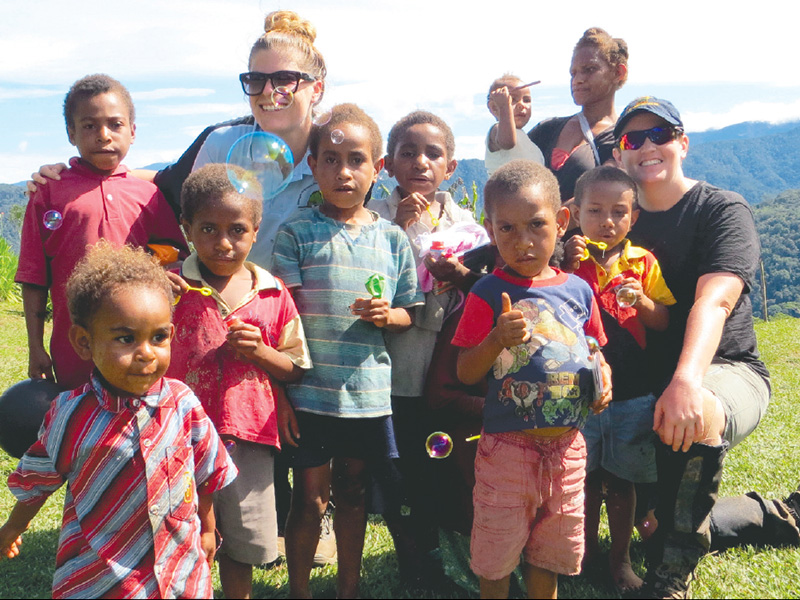Continued from last week’s story.
The Kokoda Track is a distance of 96km and its highest point is 2200m, nearly as high as Mt Kosciuszko, Australia’s highest point. The journey took Mandy and her group 9 days from the first archway until they reached the end archway.
NSW Police Legacy coordinate the treks and run a continual program for legatee families who have lost a loved one in the line of duty. Each year they run a trip to Kokoda and members of other emergency services across Australia also take part to raise funds for their programs.
The company used by NSW Legacy is ‘Our Spirit’ and its founding CEO, Aiden Grimes has lead the group 88 times through the treacherous area. Mandy said that the group were protected by armoured guards throughout the trip and were assisted by descendants of members of the original Fuzzy Wuzzy Angels who carried injured Diggers and medical supplies through the area during WWII. She said that the current Fuzzy Wuzzies are referred to as ‘Legends’ due to the respect and history between the two countries.
The reality of the track hit home for Mandy when memorials began appearing along the way from modern day treckers who had passed away on the track. She said that people had lost their lives from heart attacks or asthma attacks and other complication during the gruelling 9 days. Mandy said that her tour operators had never lost anyone which filled her with confidence.
Throughout the trail the group was educated by the team leaders and the ‘Legends’ about the many battles that occurred in different parts, which she found informative and interesting.
When asked how she got through the trek Mandy said “its more of a mental strain than a physical one but the army medics on hand via the tour group were able to administer medications strapping and general first aid”.
Hydration played an enormous role in keeping the body in working order. “I consumed 5 litres of water each day”. Mandy said “there were times when the only thing you saw at eye level was the ankles of the person in front of you” such was the incline of the track.
“The track was so narrow in parts that you had to place one foot infront of the other whilst surrounded by bushes. Other times you were ankle deep in mud”.
She said “The legends, like their forefathers, have the ability and physical fitness to carry anyone who is injured to safety. She said “they drop their gear and do it if they have to”.
Finishing the day before Anzac Day the team headed back to the lock down accommodation facilities. Mandy made special comment of being able to eat “real food, have access to showers flushing toilets, clean water and clean clothes”.
She said a high light of the trip was the Anzac Day Dawn Service with the Prime Minister of Papua New Guniea and representatives from New Zealand and Australia in attendance. Members of the emergency services who did the trek with Mandy participated in the Anzac Day proceedings and wore full dress uniform. A fly over occurred by Papua New Guinea’s Airforce and the national anthems of all 3 nations were played.
After attending the ceremony the group travelled to the Port Moresby Yacht Club where they played two up, ate hot pies with sauce and enjoyed the rest of Anzac day.
Mandy said she had some nasty falls on the track as did the other members however it was a little inoccuous slip that resulted in her breaking her radius bone in her arm. She still had 3 days to go on the trip and the medics attended to her and strapped it up. The pain from the spiral break meant that Mandy knew she had broken it straight away.
She was assisted through the last 3 days of the journey with her broken arm by the rest of the party. If she needed that extra help to climb a large stone or up a particulary steep incline a helpful hand was always there. The medics would provide pain relief and she would keep going.
To put her injury in perspective she said another member injured his knee seriously and that she felt bad for him because she could lift her arm up and elevate it, but he had to walk on it it every step.
The hardest part of continuing with her injury was when she described reaching a steep decline and having to ‘walk down a slippery dip full of mud’ without hurting her arm further.
Mandy said that she feels empowered by the trek and feels she can achieve anything. She said when you think you are having a bad day, you should think of what the Diggers endured as they suffered from Malaria and Dysentry whilst fighting the enemy. She said we had a constant supply of food and water, socks and good shoes and they had none of these luxuries.
Mandy said she may head to South America or Africa next and that she is very glad to have been able to tick The Kokoda Track off her bucket list as it is such a special place for Australians.
The day after Anzac Day Mandy flew out from Port Moresby and back to Brisbane and then onto Sydney. Mandy said that the conversations she had with John O’Connor before she left were very useful in guiding her with planning her trip, John previously having completed the Track.
Mandy is now back working at the Terracotta with her family and the arm is healing nicely.

